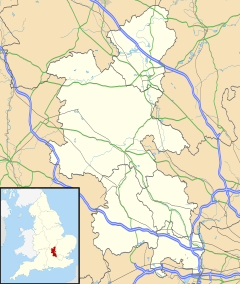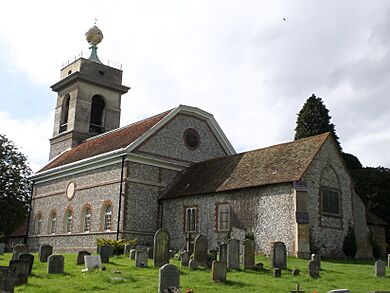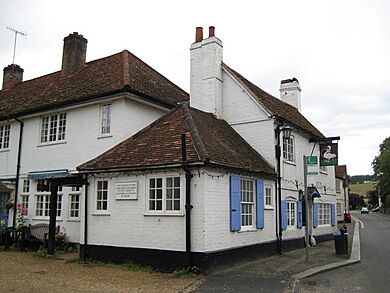West Wycombe facts for kids
Quick facts for kids West Wycombe |
|
|---|---|
 The Mausoleum on West Wycombe Hill |
|
| Population | 1,345 (2011 Census) |
| OS grid reference | SU830945 |
| Civil parish |
|
| Unitary authority |
|
| Ceremonial county | |
| Region | |
| Country | England |
| Sovereign state | United Kingdom |
| Post town | HIGH WYCOMBE |
| Postcode district | HP14 |
| Dialling code | 01494 |
| Police | Thames Valley |
| Fire | Buckinghamshire |
| Ambulance | South Central |
| EU Parliament | South East England |
| UK Parliament |
|
West Wycombe is a small village in Buckinghamshire, England. It is famous for its old manor houses and beautiful hills. The village is about 3 kilometers (2 miles) west of High Wycombe.
Much of the historic village is owned by the National Trust. This means it is protected and kept looking like it did in the past. Many tourists visit each year to see places like West Wycombe Park, the West Wycombe Caves, and the impressive Mausoleum on West Wycombe Hill. The Mausoleum and a golden ball on top of the hill are easy to spot landmarks. They can be seen from miles around.
West Wycombe Park, the Caves, the Mausoleum, and St Lawrence's Church were all built in the mid-1700s. They were created by Sir Francis Dashwood. He was a very important person who founded the Dilettanti Society. He also helped start a famous club called the Hellfire Club.
Contents
Discovering West Wycombe's Past
Ancient Times: Early Settlers

The hill above West Wycombe has been lived on for a very long time. People believe a settlement from the Bronze Age (around 2500-800 BC) was here. Some research even suggests there was an ancient temple, similar to Stonehenge.
The oldest known settlement was an Iron Age camp. It had a ditch and rampart (a wall of earth) and dates back to the fourth or fifth century BC. Later, a Roman settlement was built on West Wycombe Hill. Local historians think the Romans also built a temple here, but its exact location is still a mystery.
Haveringdon: A Lost Village
The Saxons were the next major group to influence West Wycombe. They settled on the hillside and named their new village Hæferingdune. This name meant Hill of Hæfer's people in Old English. Over time, the name changed to Haveringdon.
The site remained important for religious reasons. It is said that St Birinus, who became a bishop in AD 634, built a church here. A Norman watch tower was also built on top of the hill.
Haveringdon's population likely became much smaller because of the Bubonic Plague, also known as the Black Death, in the 1340s. By the 1700s, the village had moved down into the valley. It was renamed "West Wycombe" because it was west of High Wycombe. Both villages are in the Wye Valley. The word "Combe" comes from an old word for "valley." Records show that by the 1800s, only two people were left living in Haveringdon.
The Georgian Era and Sir Francis Dashwood
In the mid-1700s, Sir Francis Dashwood started a huge project. He wanted to get chalk to build a straight, three-mile road. This road connected West Wycombe to High Wycombe. It is now part of the A40 road, which was an important trade route. It linked London, Oxford, Gloucester, and even South Wales.
The local chalk cave, which had been in the village since ancient times, was made much bigger. It became a large network of tunnels and passages. The design of these caves was inspired by Dashwood's travels in Italy, Greece, and the Ottoman Empire.
Local villagers, who were poor after several bad harvests, were paid to dig the chalk. They earned a shilling (an old coin) per day. The caves were all dug by hand. Even today, they are seen as an amazing engineering achievement.
Dashwood's family home, West Wycombe House, was also changed a lot during this time. Even though Haveringdon had mostly disappeared, the old church and tower remained. A new middle section was built to connect them. The Mausoleum was also built, designed like the Constantine Arch in Rome. The new church was named Saint Lawrence's. This name was often given to churches built on old Pagan sites. Both the church and Mausoleum were built using chalk and flint from the caves.
During this time, Dashwood and other powerful politicians formed a club. It was first called The Knights of St. Francis. Later, a London newspaper called it the Hellfire Club. They first met at Medmenham Abbey, but later used the caves for their meetings. The club stopped meeting by 1763. After this, the caves were not used and fell apart.
West Wycombe in the 1900s
In 1929, the Dashwood family decided to sell West Wycombe village. They needed money after the Wall Street Crash of 1929. The entire village was bought by the Royal Society for the Encouragement of Arts, Manufactures and Commerce (RSA). They bought it to help save old cottages. In 1934, after many repairs, the RSA gave the property to the National Trust. The National Trust now calls it 'West Wycombe Village and Hill'. This property has many beautiful buildings built between the 1500s and 1700s.
From 1862 to 1958, the village had its own train station, West Wycombe railway station. It was part of the Chiltern Main Line that connected London and Birmingham.
In the late 1940s and early 1950s, the caves were repaired by the Dashwood family. They turned them into a place for tourists to visit. The money earned from the caves was used to fix up the old West Wycombe Park. The caves are still a popular tourist spot today. Over 2 million people have visited them since they reopened in 1951.
West Wycombe Today
Even though West Wycombe is on the busy A40 road, its village center still feels very old and charming. The National Trust owns most of it, which helps keep it from becoming too modern. The High Street has several shops that look old-fashioned. There are also three pubs, some small offices, and a busy village hall. Just off the High Street, you can find the village primary school (for children aged 4-11), a traditional furniture maker, and a band hall. The village has about 1,300 people living there.
St Lawrence’s Church was an old medieval building until the mid-1700s. Between 1752 and 1762, Sir Francis Dashwood had it rebuilt by the architect John Donowell. The inside of the church was inspired by the Temple of the Sun in Palmyra. The church tower has a large golden globe on top. This globe originally had seats inside for eight people!
The Swan is a pub that is a Grade II listed building. This means it is an important historical building. It is also on the Campaign for Real Ale's list of historic pub interiors. The Swan was built in the 1700s. It was updated and made bigger in 1932 by Wheelers Wycombe brewery.
West Wycombe is also a civil parish in the Wycombe district.




